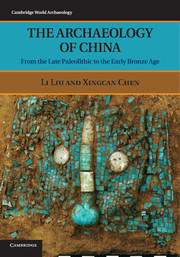Book contents
- Frontmatter
- Contents
- Illustrations
- Tables
- Preface
- Chapter 1 Chinese archaeology: Past, present, and future
- Chapter 2 Environment and ecology
- Chapter 3 Foragers and collectors in the Pleistocene-Holocene transition (24,000–9000 cal. BP)
- Chapter 4 Domestication of plants and animals
- Chapter 5 Neolithization: Sedentism and food production in the early Neolithic (7000–5000 BC)
- Chapter 6 Emergence of social inequality – The middle Neolithic (5000–3000 BC)
- Chapter 7 Rise and fall of early complex societies: The late neolithic (3000–2000 BC)
- Chapter 8 Formation of early states in the Central Plain: Erlitou and Erligang (1900/1800–1250 BC)
- Chapter 9 Bronze cultures of the northern frontiers and beyond during the early second millennium BC
- Chapter 10 The late shang dynasty and its neighbors (1250–1046 BC)
- Chapter 11 Chinese civilization in comparative perspective
- Appendix Horse bones in faunal assemblages from Neolithic and early Bronze Age sites in north China
- Glossary
- References
- Index
Chapter 6 - Emergence of social inequality – The middle Neolithic (5000–3000 BC)
Published online by Cambridge University Press: 05 June 2012
- Frontmatter
- Contents
- Illustrations
- Tables
- Preface
- Chapter 1 Chinese archaeology: Past, present, and future
- Chapter 2 Environment and ecology
- Chapter 3 Foragers and collectors in the Pleistocene-Holocene transition (24,000–9000 cal. BP)
- Chapter 4 Domestication of plants and animals
- Chapter 5 Neolithization: Sedentism and food production in the early Neolithic (7000–5000 BC)
- Chapter 6 Emergence of social inequality – The middle Neolithic (5000–3000 BC)
- Chapter 7 Rise and fall of early complex societies: The late neolithic (3000–2000 BC)
- Chapter 8 Formation of early states in the Central Plain: Erlitou and Erligang (1900/1800–1250 BC)
- Chapter 9 Bronze cultures of the northern frontiers and beyond during the early second millennium BC
- Chapter 10 The late shang dynasty and its neighbors (1250–1046 BC)
- Chapter 11 Chinese civilization in comparative perspective
- Appendix Horse bones in faunal assemblages from Neolithic and early Bronze Age sites in north China
- Glossary
- References
- Index
Summary
When the ancients buried their dead, they covered the body thickly with pieces of wood, having laid it in the open country. They raised no mound over it, nor planted trees around; nor had they any fixed period for mourning. In subsequent ages the sages substituted for these practices the inner and outer coffins.
Chapter, “The Great Treatise II,” in Book of Changes (ca. the ninth century BC), translated by James Legge (1879)“古之葬者, 厚衣之以薪, 葬之中野, 不封不树, 丧期无数。后世圣人易之以棺槨…” 《周易 · 系辞下》
During the fifth and much of the fourth millennia BC, fully developed Neolithic communities flourished in most of China. Settlements increased dramatically in number, and spread to ever broader and more varied geographic regions, suggesting a rapid growth in population. These developments coincided with a period of warm and wet climatic conditions known as the Mid-Holocene Climatic Optimum, during which some large-scale centennial warming was accompanied by increased precipitation, due to the expansion of monsoon circulation. The deviation of annual mean temperature from today's is estimated at 1°C in South China, 2°C in the Yangzi Valley, and 3°C in North and Northeast China (Shi, Y. et al. 1993). It appears that the northwest of China experienced the strongest warming, as the mean temperature was 3–4°C higher than today near the Tenggeli (Tengger) Desert around 7290–6380 cal. BP (Zhang, H. C. et al. 2000). The duration and amplitude of the Optimum period, as well as the times of its start and end, differed in different parts of China, however, and a cooling/drying event that followed the Optimum was also asynchronous (An, C.-B. et al. 2006; An, Z. et al. 2000; He, Y. et al., 2004). A number of studies show that this episode of climatic deterioration seems to have occurred around 5000 cal. BP in many parts of north China (An, C.-B. et al. 2006; Li, Xiaoqiang et al. 2003; Schettler et al. 2006). These conditions are the environmental backdrop underlying the economic and social decisions made by the Neolithic communities.
- Type
- Chapter
- Information
- The Archaeology of ChinaFrom the Late Paleolithic to the Early Bronze Age, pp. 169 - 212Publisher: Cambridge University PressPrint publication year: 2012
- 2
- Cited by



